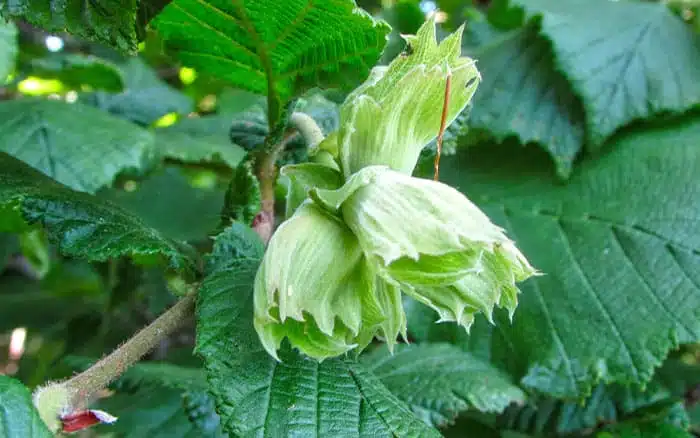Cobnuts are used like any other nut, eaten as a snack, used in baked goods, or mixed into a salad for added crunch. They are a variety of hazelnut that grow in the UK, so find out more about growing them here…
What are they?
Cobnuts are a type of hazelnut that was traditionally grown in Kent, England – that’s why they’re commonly known as Kentish cobnuts.
Cobnuts have short husks which are papery coverings which the nut comes out from.
Cobnut conditions
The best time to plant trees is between November and March because this is when the tree is dormant. When planting, bear in mind that cobnuts grow best in a sunny spot, however they will also tolerate partial shade.
A sheltered location is best, out of frost pockets because they aren’t fully hardy so low temperatures can affect cropping.
They can grow on a variety of soil types, but a light sandy and well-drained soil is best, because fertile soils can lead to vigorous growth which are difficult to keep under control and with smaller yields.

Pollination station
As monoecious trees, there are male and female flowers on the same tree. The plants are wind pollinated, so when grown in groups they’ll have a better crop. In addition, planting them in a square will help to boost pollination more.
The female flowers develop into nuts if they are fertilised with the pollen from the male flowers. The catkins that bloom in winter produce the pollen which is spread by the wind.

Upkeep and care
Keep them growing their best by feeding annually with a balanced fertiliser in winter. It’s also ideal to mulch around the base of young trees which helps to retain moisture and suppress weeds.
Pruning will help to keep the plant in check, but it will differ slightly depending on how established the tree is. For example, in summer, new shoots that are growing low down on the plant or any badly positioned ones should be removed. The sideshoots that are in a good position should be pruned back by a third.

Then, come winter, any excessive strong, upright growth can be removed. Meanwhile the sideshoots can be pruned slightly at the tips to create a good, balanced structure and frame. The structure you’re looking for is an open-centred shape with a maximum of 10 leaders that are growing up and out.
For established plants, summer pruning involves breaking long sideshoots by hand, bending them in half but leaving the broken sections hanging on – this is called ‘brutting’. Then, in winter to open up the framework by shortening the ‘brutted’ branches to three or four buds.
This is the time to remove up to a third of old or overcrowded growth to 2.5cm. This pruning will disturb the tree, resulting in more pollen being released to increase pollination.
Take your pick
Cobnuts will be produced from 3 or 4 years and will be ready for harvest around September when the husks start turning yellow.
It might be wise to harvest your cobnuts before they ripen if squirrels are an issue in your area. But this could result in them not having quite the best flavour.
Once harvested, store them in a dry, airy room, turned evenly to ensure they dry completely and evenly. When they are dry, remove the husks and store them in the same space as previously.

The nuts can be eaten freshly picked or give them a boost of flavour by roasting them lightly in the oven and adding a sprinkle of salt.
There are many cultivars to get growing such as ‘Purple Filbert’ that has red-purple leaves but is more of an ornamental choice. ‘Hall’s Giant’ produces large nuts and is a hardy pick. ‘Butler’ is a heavy cropper and a popular one to choose.
Or give ‘Kent Cob’ a try which is a reliable grower with a lovely flavour…
- Catkins flower in winter and spring
- Hardy
- Grows up to 3m tall
- Well-drained soil
- Full sun or partial shade
- Exposed or sheltered
Cobnut vs filbert
You may see these names used interchangeably which can cause some confusion. However here’s how it works…cobnuts are hazelnuts that are harvested and eaten fresh. Filberts are a type of cobnut where the nut is completely encased by the husk.

Leave A Comment